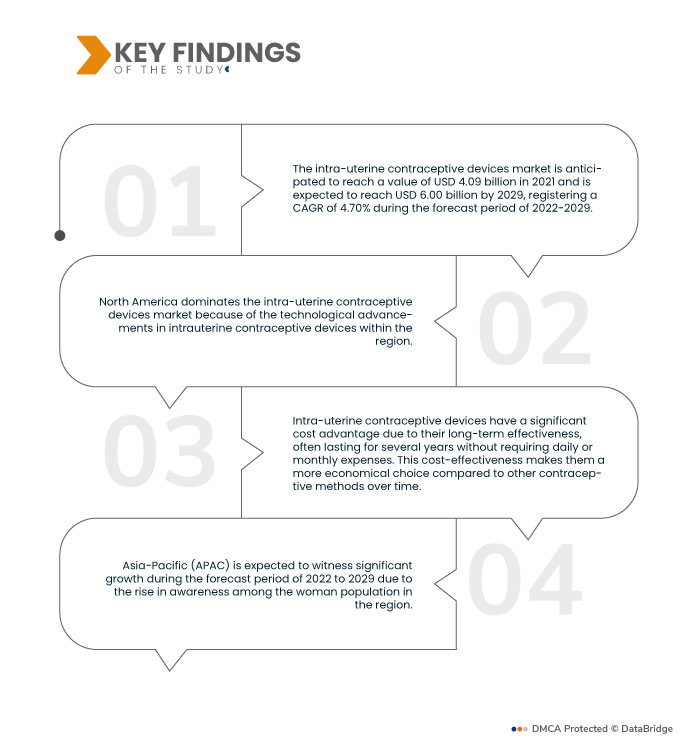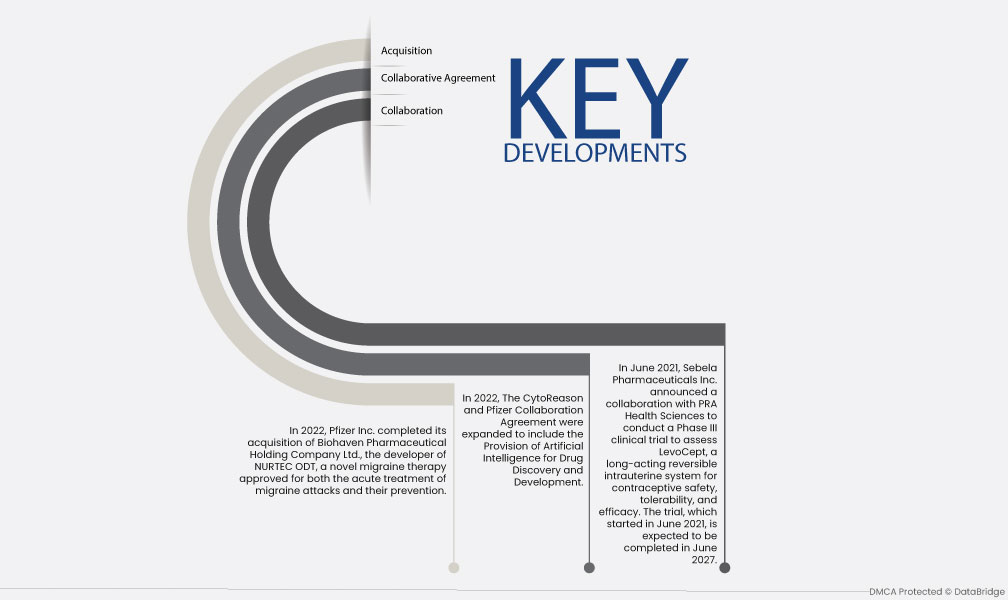The Global Intra-Uterine Contraceptive Devices Market is witnessing a remarkable surge, empowering women with safe and effective family planning solutions. These devices offer long-term contraception with high efficacy and convenience. The market benefits from increasing awareness about reproductive health and the need for reliable birth control methods. As a result, more women are embracing intra-uterine contraceptive devices for their reversible nature and minimal side effects. With supportive regulatory frameworks and expanding healthcare access, the market promises a brighter future for women's reproductive choices worldwide.
Access Full Report: https://www.databridgemarketresearch.com/zh/reports/global-intra-uterine-contraceptive-devices-market
Data Bridge Market Research analyses that the intra-uterine contraceptive devices market is expected to grow to USD 4.09 billion in 2021 and is expected to reach USD 6.00 billion by 2029, registering a CAGR of 4.70% during the forecast period of 2022-2029. Non-hormonal intra-uterine devices appeal to women seeking contraception without hormonal side effects, providing an alternative to traditional hormonal methods.
Key Findings of the Study
Rising female workforce participation is expected to drive the market's growth rate
With rising female workforce participation, women seek birth control options that offer convenience and reliability to manage their career and family planning effectively. Intra-uterine contraceptive devices fulfill these requirements, as they provide long-term contraception without daily adherence. This increased need for practical and dependable birth control methods leads to higher demand for intra-uterine devices among working women. Offering the flexibility to focus on professional growth while maintaining reproductive choices, these devices become a preferred option in the market.
Report Scope and Market Segmentation
|
Report Metric
|
Details
|
|
Forecast Period
|
2022 to 2029
|
|
Base Year
|
2021
|
|
Historic Years
|
2020 (Customizable to 2014 - 2019)
|
|
Quantitative Units
|
Revenue in USD Billion, Volumes in Units, Pricing in USD
|
|
Segments Covered
|
Type (Hormonal Intrauterine Device, Copper Intrauterine Device), Product Type (Mirena, Skyla, Paragard, Essure, Levosert, Others), End User (Hospitals, Gynecology Clinics, Community Health Care Centers, Others)
|
|
Countries Covered
|
U.S., Canada and Mexico in North America, Germany, France, U.K., Netherlands, Switzerland, Belgium, Russia, Italy, Spain, Turkey, Rest of Europe in Europe, China, Japan, India, South Korea, Singapore, Malaysia, Australia, Thailand, Indonesia, Philippines, Rest of Asia-Pacific (APAC) in the Asia-Pacific (APAC), Saudi Arabia, U.A.E, South Africa, Egypt, Israel, Rest of Middle East and Africa (MEA) as a part of Middle East and Africa (MEA), Brazil, Argentina and Rest of South America as part of South America
|
|
Market Players Covered
|
Teva Pharmaceutical Industries Ltd. (Jerusalem), Bayer (Germany), EUROGINE (Spain), CooperSurgical Inc. (U.S.), Pfizer Inc. (U.S.), HLL Lifecare Limited (Thiruvananthapuram), OCON Medical Ltd. (Israel), Prosan International BV (Netherlands), Melbea Innovations (Hungary), Allergan, Merck & Co., Inc. (U.S.), DKT International (U.S.), Medisafe Distribution Inc. (Canada), Medicines360 (U.S.), Pregna International Limited (India), and Egemen International (Turkey), among others
|
|
Data Points Covered in the Report
|
In addition to the insights on market scenarios such as market value, growth rate, segmentation, geographical coverage, and major players, the market reports curated by the Data Bridge Market Research also include depth expert analysis, patient epidemiology, pipeline analysis, pricing analysis, and regulatory framework.
|
Segment Analysis:
The intra-uterine contraceptive devices market is segmented on the basis of type, product type and end user.
- On the basis of type, the intra-uterine contraceptive devices market is segmented into hormonal intrauterine device and copper intrauterine device.
- On the basis of product type, the intra-uterine contraceptive devices market is segmented into mirena, skyla, paragard, essure, levosert, and others.
- On the end user segment of intra-uterine contraceptive devices market is segmented into hospitals, gynecology clinics, community health care centers, and others.
Major Players
Data Bridge Market Research recognizes the following companies as the major global intra-uterine contraceptive devices market players in global intra-uterine contraceptive devices market are CooperSurgical Inc. (U.S.), Pfizer Inc. (U.S.), HLL Lifecare Limited (Thiruvananthapuram), OCON Medical Ltd. (Israel), Prosan International BV (Netherlands), Melbea Innovations (Hungary), Allergan, Merck & Co., Inc. (U.S.), DKT International (U.S.), Medisafe Distribution Inc. (Canada), Medicines360 (U.S.)
Market Developments
- In 2022, Pfizer Inc. completed its acquisition of Biohaven Pharmaceutical Holding Company Ltd., the developer of NURTEC ODT, a novel migraine therapy approved for both the acute treatment of migraine attacks and their prevention.
- In 2022, The CytoReason and Pfizer Collaboration Agreement were expanded to include the Provision of Artificial Intelligence for Drug Discovery and Development.
- In June 2021, Sebela Pharmaceuticals Inc. announced a collaboration with PRA Health Sciences to conduct a Phase III clinical trial to assess LevoCept, a long-acting reversible intrauterine system for contraceptive safety, tolerability, and efficacy. The trial, which started in June 2021, is expected to be completed in June 2027.
Regional Analysis
Geographically, the countries covered in the global intra-uterine contraceptive devices market report are U.S., Canada and Mexico in North America, Germany, France, U.K., Netherlands, Switzerland, Belgium, Russia, Italy, Spain, Turkey, Rest of Europe in Europe, China, Japan, India, South Korea, Singapore, Malaysia, Australia, Thailand, Indonesia, Philippines, Rest of Asia-Pacific (APAC) in the Asia-Pacific (APAC), Saudi Arabia, U.A.E, South Africa, Egypt, Israel, Rest of Middle East and Africa (MEA) as a part of Middle East and Africa (MEA), Brazil, Argentina and Rest of South America as part of South America.
As per Data Bridge Market Research analysis:
North America is the dominant region in the global intra-uterine contraceptive devices market during the forecast period 2022-2029
North America's dominance in the intra-uterine contraceptive devices market can be attributed to its continuous focus on technological advancements in this field. The region's robust research and development initiatives lead to the introduction of innovative and improved intra-uterine contraceptive devices with enhanced user experience and effectiveness. These advancements create a competitive edge for North American manufacturers, attracting both domestic and international customers, and contributing to the region's leadership position in the global market.
Asia-Pacific is estimated to be the fastest growing region in the global intra-uterine contraceptive devices market for the forecast period 2022-2029
Asia-Pacific region is expected to experience substantial growth in the intra-uterine contraceptive devices market. This growth can be attributed to the increasing awareness among women in the region about reproductive health and family planning. As awareness spreads and education on contraceptive options improves, more women are likely to consider intra-uterine devices as a reliable and convenient birth control solution, driving the market's expansion in Asia-Pacific.
For more detailed information about the intra-uterine contraceptive devices market report, click here – https://www.databridgemarketresearch.com/zh/reports/global-intra-uterine-contraceptive-devices-market















